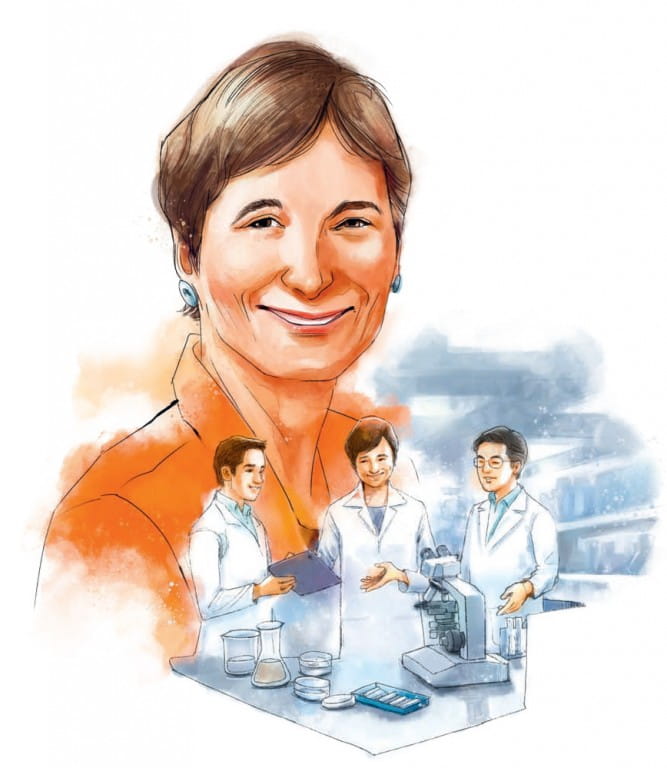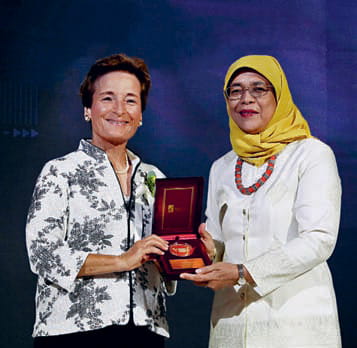Stories > Incubating Excellence
Incubating Excellence
Dr Judith Swain, who is credited with helping to develop Singapore’s nascent biomedical science industry in the 2000s, distils the success of its long-term vision.
BY CHARLIE SHAPIRO
ILLUSTRATION KEN LEE
ost Singaporeans have charted the rise of their country’s biomedical sciences industry over the past 20 years through its commercialised therapies and research breakthroughs. However, few are familiar with the visionaries who helped mould it into a world-class landscape that attracts top local and foreign talent.
One such individual is American physician scientist Dr Judith Swain, who first joined the Agency for Science, Technology and Research’s (A*STAR) Graduate Academy International Advisory Committee in 2002 to boost its efforts in training physician scientists.
Having spent over 11 years living in Singapore, Dr Swain has witnessed major developments in the field. “Over the past 20 years, the National University of Singapore [NUS] and Nanyang Technological University [NTU] have grown from not A*STAR in 2006 during the second phase of Singapore’s Biomedical Sciences (BMS) Initiative. This was launched in 2000 to realise the country’s vision of becoming a leading international biomedical sciences cluster that advances human health.
Her first task was to establish A*STAR’s Singapore Institute for Clinical Sciences (SICS) to build clinical and translational research. In the past 14 years, Dr Swain and Dr Holmes, who was conferred the Honorary Citizen Award for his valuable contributions to Singapore in 2011, have enriched the biomedical research sector in the country.
NURTURING NEW LEADERS
As she had already visited the country for work on several occasions, Dr Swain did not face cultural challenges upon moving here. The San Diego native regaled her friends back home with accounts of a clean and safe modern city with an amazing variety of food. She swiftly grew to appreciate its people too. “My colleagues at A*STAR showed me how warm and welcoming Singaporeans are,” she recalls.
While she had been impressed by the professionalism of Singaporean researchers and students she had briefly met on her previous trips to the Lion City, she now found herself gaining a new appreciation for their culture. “Having interacted with a wider group of Singaporeans, I found that they are generally interested in giving feedback to their political leaders, and deeply committed to education,” she shares.
And although Dr Swain in her new role at a statutory board had to get used to a large volume of paperwork, she shares that she was fortunate to have talented administrative directors who helped move programmes at SICS along in a timely fashion. Certainly, such efficiency was crucial to accelerating the growth of clinical and translational research in Singapore.
At the most basic level, clinical research is the testing of theory and application, while translational research facilitates the connection between the study and its practical applications to people.
Dr Swain is a firm believer in the importance of physician scientists. “They often identify the clinical need for new diagnostics and therapies, then work in teams with a full range of scientists and engineers. Furthermore, those trained as physician scientists make excellent teachers in clinical medicine because they are rigorous about undertaking an evidence based approach to patient care,” she posits.
“The Local Environment Has Facilitated Knowledge Exchange And Innovation, As Reflected In Singapore’s Excellent Track Record In Not Only Growing Local Talent But Also Attracting Top Scientists And Engineers From Around The World. This Allows For A Diversity Of Ideas And Experiences.”
Dr Judith Swain, Visiting Professor, NUS YLLSoM
To groom them, she helped to develop programmes, including the National Medical Research Council’s Clinician Scientist Awards, which provides salary and funding support for both junior and senior Singaporean clinician investigators. She cites Associate Professor Ronald Lee Chi-Hang, a senior consultant cardiologist at the National University Hospital, as an example of a physician scientist who is translating research into beneficial healthcare solutions.
“Through his research on sleep-disordered breathing in Asian populations, Lee revealed a strong association between sleep disorders and cardiovascular disease in Singaporeans. He is currently testing an oral device that may be much more effective than the standard therapy used to treat sleep apnoea,” shares the cardiologist by training.>

Dr Judith Swain is one of the pioneer clinical and translational research experts in Singapore’s thriving biomedical research sector, and has helped groom numerous physician scientists in the country.
WORKING IN SYMBIOSIS
That said, physician scientist development is just one aspect of Singapore’s BMS initiative, whose success, Dr Swain asserts, is the sum of its parts.
“There are strong basic sciences, particularly at the universities, a thriving clinician investigator community that receives the necessary support to translate science to clinical outcomes, along with facilities and programmes to fund basic curiosity-driven research. This has come about because of visionary leaders and a government willing to invest for the long term,” she states.
In addition, the visiting professor in the Yong Yoo Lin School of Medicine (YLLSoM) at NUS is heartened to see the growth of physician scientist training at institutes such as YLLSoM, Duke-NUS Medical School and NTU’S Lee Kong Chian School of Medicine.
It has been interesting, too, for her to chart the sector’s evolution, from its wooing of multinational pharmaceutical companies to set up shop here, to its focus on small companies leading to new therapies. “The local environment has facilitated knowledge exchange and innovation, as reflected in Singapore’s excellent track record in not only growing local talent but also attracting top scientists and engineers from around the world. This allows for a diversity of ideas and experiences,” she says.
“Having Interacted With A Wider Group Of Singaporeans, I Found That They Are Generally Interested In Giving Feedback To Their Political Leaders, And Deeply Committed To Education.”
But how does Singapore’s efforts in scaling up its biomedical science industry stack up against the rest of the world’s, considering its small stature? According to her, the Little Red Dot is a force to be reckoned with despite its size. “Singapore is agile in adopting new technology and doing it better than many other places,” she says.
THE RIGHT IMPETUS
However, she notes that Singapore’s approach may not necessarily be applicable to other countries, and vice-versa. Dr Swain observes that Singapore has the tendency to split up grant money among a larger number of applicants, as opposed to the US method of selecting a single or small number of winners. This, she says, can be attributed to cultural differences.

President Halimah Yacob presents Professor Judith Swain with the President’s Science & Technology Medal at the President’s Science & Technology Awards 2018.
“Social psychologist Assistant Professor Bobby Cheon, who I hired to join SICS, helped me to understand the differences between collective versus individualistic societies [that is, Singapore versus the US].” Nonetheless, both approaches have their merits: Grant money divided among more investigators allows for more research teams, while funds allocated to a smaller number might encourage high-risk studies.
Having served as a member of the National Healthcare Group’s board of directors, the prominent scientist has also witnessed Singapore’s efforts in overseas capacity building. For example, personnel from Singapore’s Institute of Mental Health assisted in the mental trauma relief of Sichuan residents after a major earthquake hit the Chinese province in 2008. “I was impressed by their dedication to building the population’s resilience,” she says.
Although Dr Swain has stepped down from her role as executive director of SICS in 2017, and now serves as visiting faculty at the NUS, she still takes a keen interest in the country’s developments, splitting her time between Singapore and the US. “With a smart and hardworking workforce, a growing number of local entrepreneurs and a long-term investment strategy, I believe Singapore’s future is bright,” she predicts.
During trips back to the country, she also enjoys visiting the former Ford Factory for personal accounts of the Japanese Occupation, as well as shopping in Haji Lane. It seems the American has brought back more than mere physical tokens of Singapore.
“I have adopted Singaporean expressions and mannerisms, such as answering questions using the word ‘can’ instead of ‘yes’, as well as taking pictures of my food,” she laughs.
